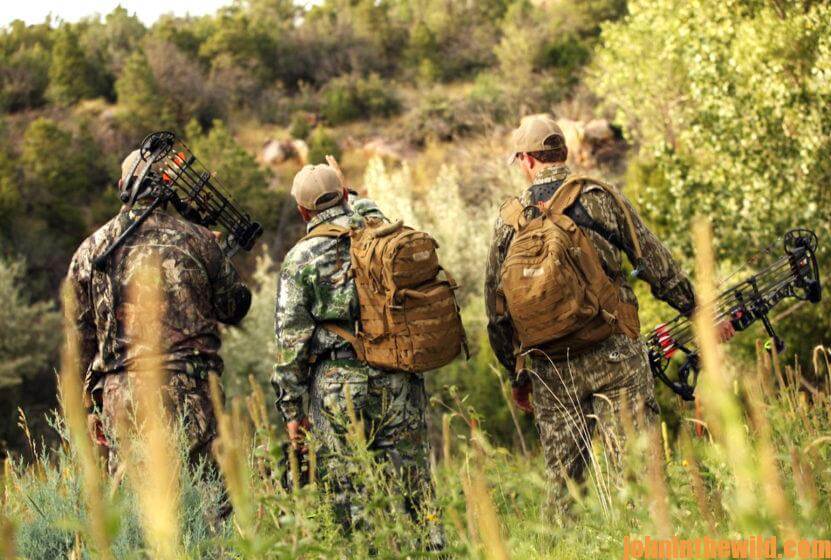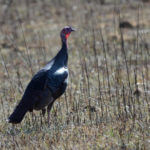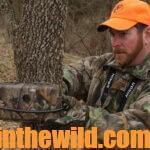Editor’s Note: I’ve known Troy Ruiz since 1994 when he first started working for Mossy Oak. After spending several years there and learning the craft of a hunting videographer, he joined forces with Will Primos to help film “The Truth Series” of videos and Primos Hunting’s TV shows (https://www.primos.com/). One thing I like about people who have to take elk every year as a part of their jobs is that they develop skills and tactics most of us may not ever consider. Here’s what I’ve learned from Troy: “We hunt three different ranches in New Mexico, Colorado and Montana. The New Mexico ranch, we hunt every year, and the Colorado and the Montana ranches we usually hunt every other year. We’ve been hunting these same ranches for many years. By hunting the same three ranches every year or every other year, we can learn where the elk are, why they’re there, and what trails they usually take to move to bedding, watering and feeding areas. I’ve also learned so much by taking meticulous notes on the dates we hunt, the weather we’re hunting in, and what other conditions are present while we’re hunting. Unless there’s a drastic change in the weather, the water supply and/or the hunting pressure, we generally can pinpoint the elk in the same places we’ve found them in previous years, which gives us a big advantage to not only find elk quickly, but to know where to set-up to try and take an older-age-class bull and to get the footage we need for Primos videos and TV shows. We’ve also learned that each person on the hunt has a different job to do, and each of the people we hunt with can play whichever role he needs to play during the hunt. This way, after one person takes an elk, he may hunt the next day either as a caller or as a videographer.
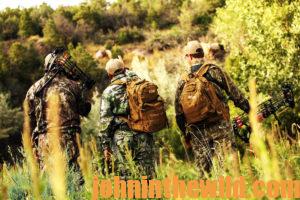 On every hunt, we have a designated shooter, a designated caller and two cameramen. The caller’s job is to put the elk in front of the archer or the gun hunter in a place where a videographer can film the elk coming in to the shooter, while the other videographer films the shooter. And as I’ve mentioned, each of the people hunting elk with us has played a role as either the shooter, the caller or the videographer. The advantage to this system of gang hunting for elk is we’ve been doing it for so long that we all know what to do, and where to be to have a successful hunt. After the shooter takes his bull, then he plays another role in the hunt, until we try to get everyone who’s with us to have the opportunity to take a bull.
On every hunt, we have a designated shooter, a designated caller and two cameramen. The caller’s job is to put the elk in front of the archer or the gun hunter in a place where a videographer can film the elk coming in to the shooter, while the other videographer films the shooter. And as I’ve mentioned, each of the people hunting elk with us has played a role as either the shooter, the caller or the videographer. The advantage to this system of gang hunting for elk is we’ve been doing it for so long that we all know what to do, and where to be to have a successful hunt. After the shooter takes his bull, then he plays another role in the hunt, until we try to get everyone who’s with us to have the opportunity to take a bull.
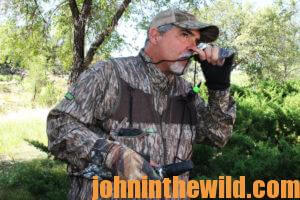 The Caller’s Responsibility: The caller should set-up 50-100 yards behind the shooter. He needs to be invisible to the elk but needs to be able to see the elk and the hunter. He also needs to move either left or right, once he hears a bull answer his call to call that bull within bow range or gun range of the shooter. The caller may use more than one call to sound like a herd of elk and/or several different bulls to fire-up the bull we’re trying to take to get that bull to come in looking for what he thinks is a cow and/or a bull. If he’s successful, the caller will put the bull coming in right in front of the shooter.
The Caller’s Responsibility: The caller should set-up 50-100 yards behind the shooter. He needs to be invisible to the elk but needs to be able to see the elk and the hunter. He also needs to move either left or right, once he hears a bull answer his call to call that bull within bow range or gun range of the shooter. The caller may use more than one call to sound like a herd of elk and/or several different bulls to fire-up the bull we’re trying to take to get that bull to come in looking for what he thinks is a cow and/or a bull. If he’s successful, the caller will put the bull coming in right in front of the shooter.
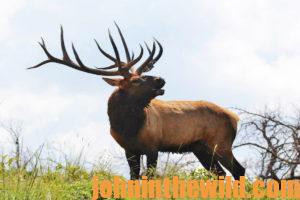 The Shooter’s Set-Up: The shooter generally sets-up about 50 – 100 yards in front of the caller. He’ll usually have a cow call in his mouth, but he won’t call to the bull. The only reason the shooter has a cow call in his mouth is to stop the bull when the bull comes in close – looking for the cow and/or bulls that have been calling to him. The bull’s full attention needs to be on the caller that’s behind the shooter. When the bull is in range, the shooter comes to full draw or pushes his safety off his rifle. Once the bull is where the shooter wants him to be, that’s the only time he blows his cow call. When the bull hears the cow call that close to him, he’s usually surprised. So, most of the time he’ll stop and look straight at the shooter. He’s trying to determine what the shooter is. As soon as the elk stops, the shooter already should be sighted-in on the elk’s vitals and release the arrow or squeeze the trigger on his rifle.
The Shooter’s Set-Up: The shooter generally sets-up about 50 – 100 yards in front of the caller. He’ll usually have a cow call in his mouth, but he won’t call to the bull. The only reason the shooter has a cow call in his mouth is to stop the bull when the bull comes in close – looking for the cow and/or bulls that have been calling to him. The bull’s full attention needs to be on the caller that’s behind the shooter. When the bull is in range, the shooter comes to full draw or pushes his safety off his rifle. Once the bull is where the shooter wants him to be, that’s the only time he blows his cow call. When the bull hears the cow call that close to him, he’s usually surprised. So, most of the time he’ll stop and look straight at the shooter. He’s trying to determine what the shooter is. As soon as the elk stops, the shooter already should be sighted-in on the elk’s vitals and release the arrow or squeeze the trigger on his rifle.
Generally, because the bull hasn’t gotten a good look at the shooter and is surprised when a cow calls to him at close range, once the elk takes the arrow, he doesn’t really know what’s happened. So, at that point, he’ll often break and run. Immediately the shooter starts calling to him, as does the caller. The caller’s trying to stop the bull to possibly give the shooter a second chance to get another arrow in the bull or to cause the bull to continue to bleed out and often to start walking-away – still wondering what just has happened to him. Often, the bull will fall within view of one of the two cameramen.

Each Cameraman Records Something Different: The cameraman who’s focused on the caller will record how, when and where the caller sets-up and moves and calls to put the elk in front of the shooter. The second cameraman is focused on the shooter and the bull. His job is to video the bull elk as he comes in to the shooter, the shooter taking the shot, the bull taking the arrow, the bull running after he takes the arrow, and hopefully the bull tipping over when he expires.
The Idea Behind Gang Hunting Elk: Taking that much equipment and that many people on an elk hunt seems complicated and appears to decrease your chances of calling and taking a bull. However, just the opposite is true. Remember all of the people on the hunt have vast knowledge and experience hunting elk and videoing elk hunts, and they’re hunting on ranches that they’ve learned over the years and hunting the same herds of elk. Also, these archers know when they can take their shots, and more importantly when not to take the shot because the weather conditions or the position of the bull isn’t right to make an ethical and lethal shot.
 Too, if you’ve ever heard elk walking through the woods or going up or coming down a mountain, you know that elk make a lot of noise. Most single elk hunters or a hunter and a caller who hunt together try to be as silent as they can be when they’re attempting to get in close to a herd of elk or to a big bull. However, elk are noisy. They step on rocks, break limbs, rake limbs with their antlers and call often when they know another elk – whether it’s a bull or a cow, is nearby. Remember that elk are herd animals. For the most part, they want to be with other elk, and the bulls want to be with the cows – especially during mating season. Never forget satellite bulls will be moving around the herd in hopes of locating a cow they can breed. So, whether a herd of elk is feeding in a meadow, bedded-down or moving through timber or the rocks, the filming crew makes noise that duplicates nature and sounds like elk traveling, bedding, feeding and/or watering.
Too, if you’ve ever heard elk walking through the woods or going up or coming down a mountain, you know that elk make a lot of noise. Most single elk hunters or a hunter and a caller who hunt together try to be as silent as they can be when they’re attempting to get in close to a herd of elk or to a big bull. However, elk are noisy. They step on rocks, break limbs, rake limbs with their antlers and call often when they know another elk – whether it’s a bull or a cow, is nearby. Remember that elk are herd animals. For the most part, they want to be with other elk, and the bulls want to be with the cows – especially during mating season. Never forget satellite bulls will be moving around the herd in hopes of locating a cow they can breed. So, whether a herd of elk is feeding in a meadow, bedded-down or moving through timber or the rocks, the filming crew makes noise that duplicates nature and sounds like elk traveling, bedding, feeding and/or watering.
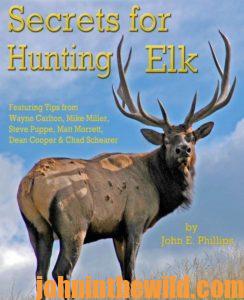 To learn more about hunting elk successfully, check out John E. Phillips’ book, “Secrets for Hunting Elk,” available in Kindle and Audible at https://www.amazon.com/.You may have to copy and paste this click into your browser. (When you click on this book, notice on the left where Amazon allows you to read 10% of the book for free). On the right side of the page and below the offer for a free Audible trial, you can click on Buy the Audible with one click.
To learn more about hunting elk successfully, check out John E. Phillips’ book, “Secrets for Hunting Elk,” available in Kindle and Audible at https://www.amazon.com/.You may have to copy and paste this click into your browser. (When you click on this book, notice on the left where Amazon allows you to read 10% of the book for free). On the right side of the page and below the offer for a free Audible trial, you can click on Buy the Audible with one click.
Tomorrow: Why Climb High for Elk



